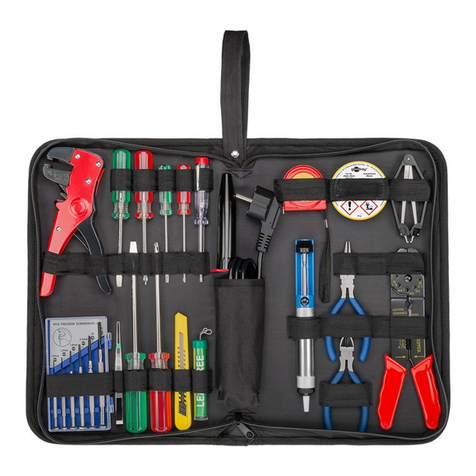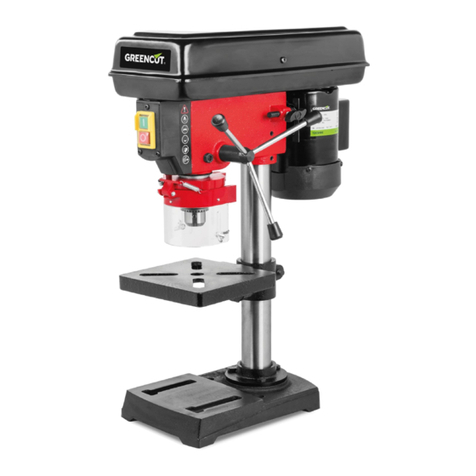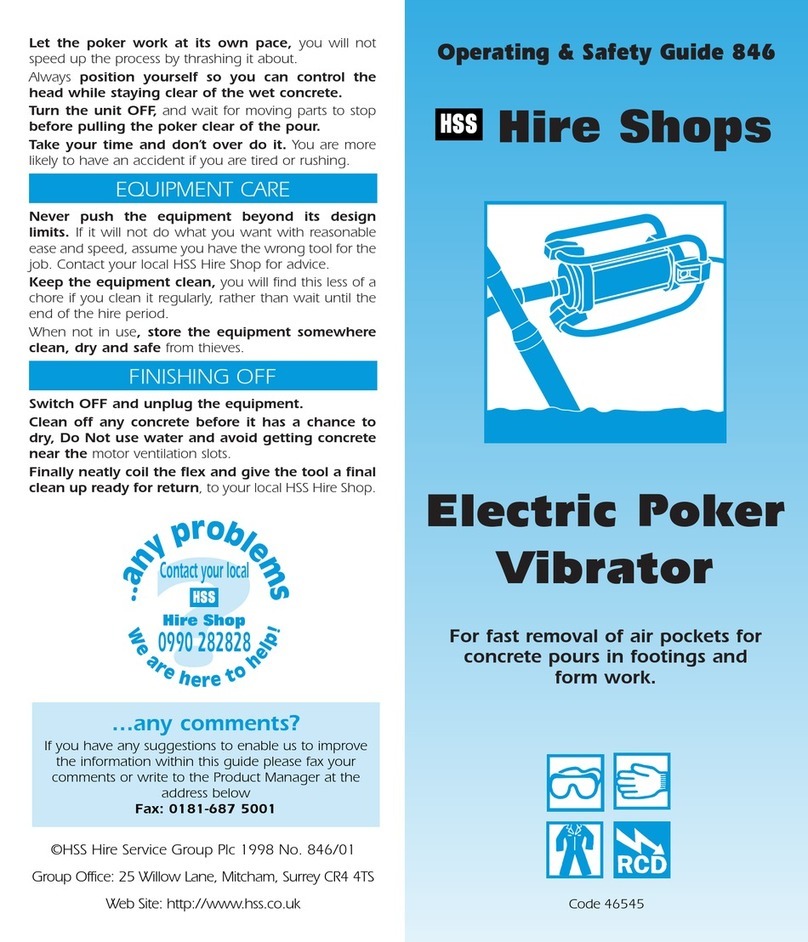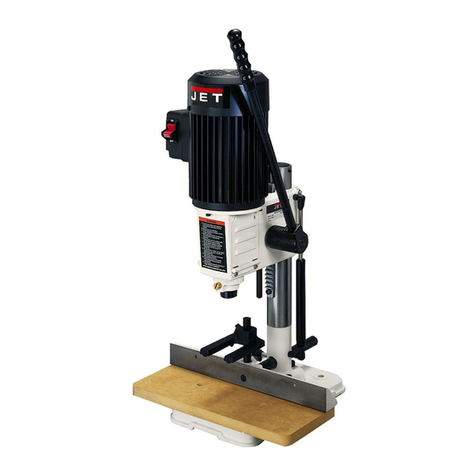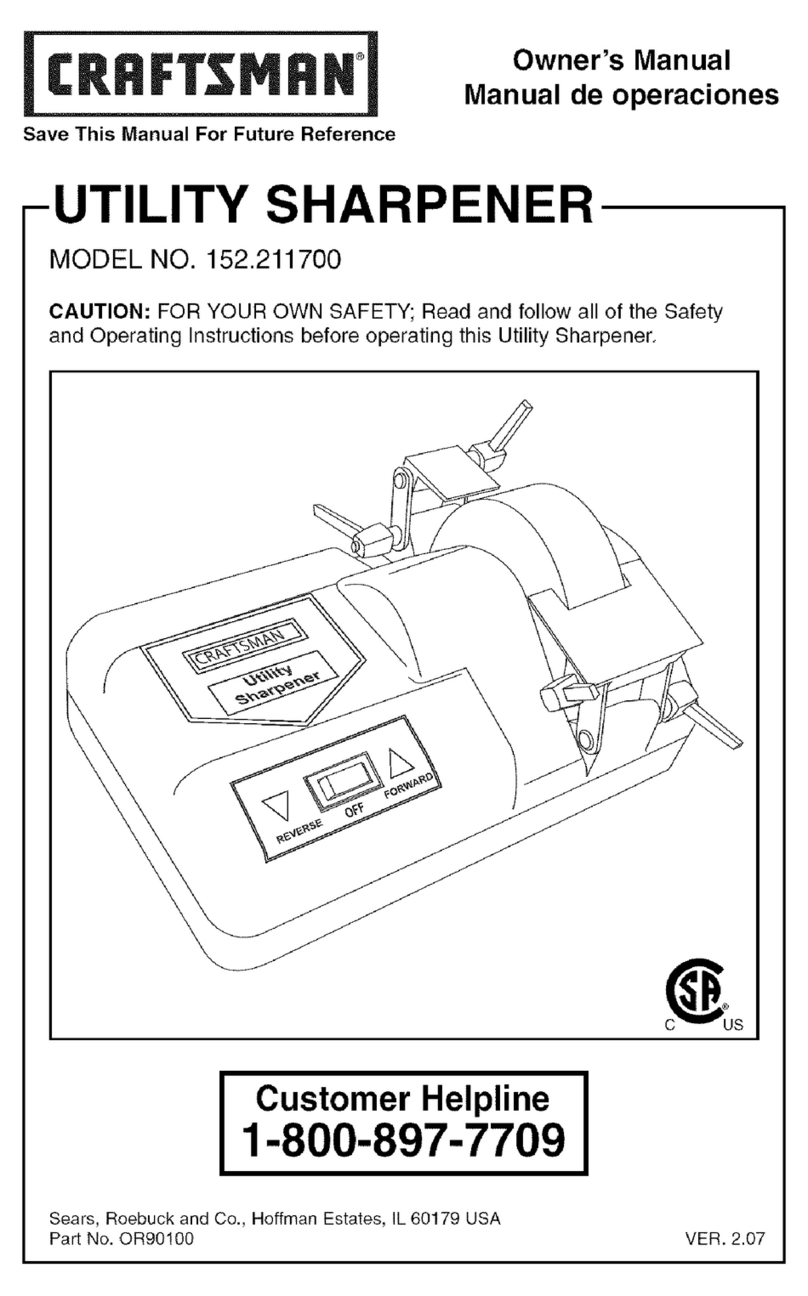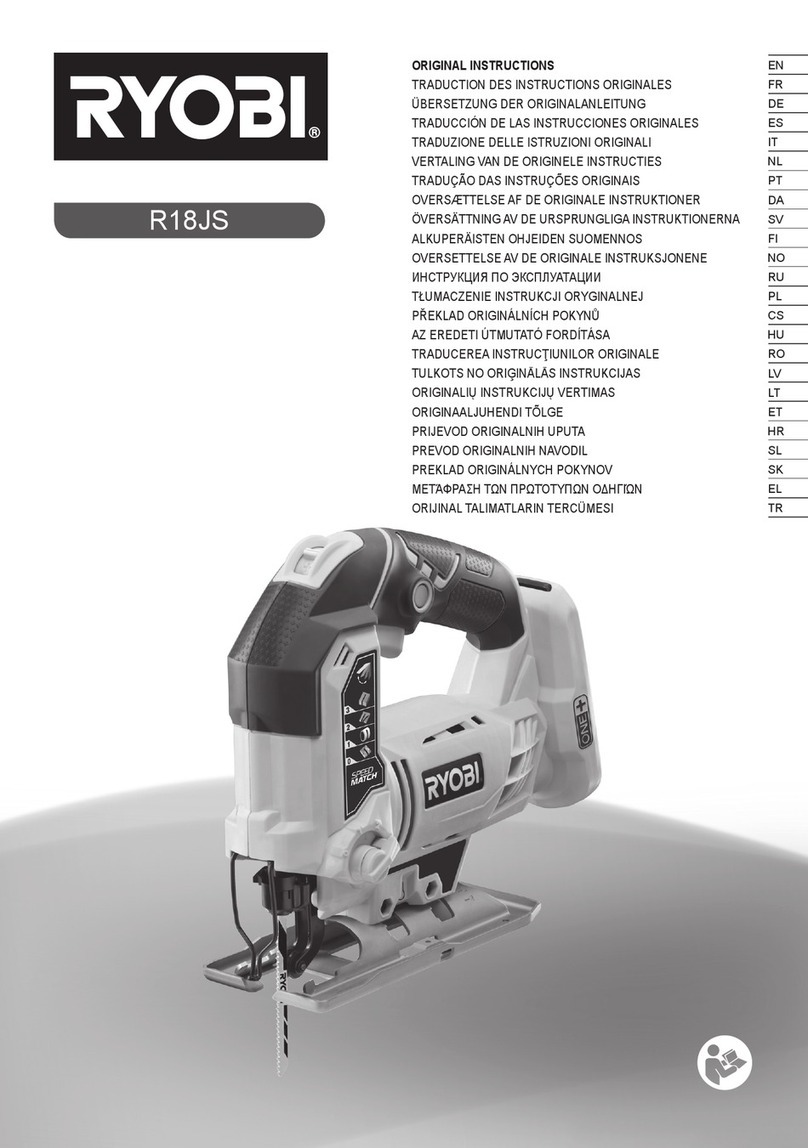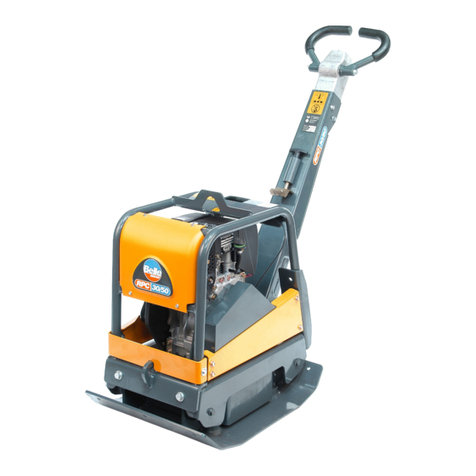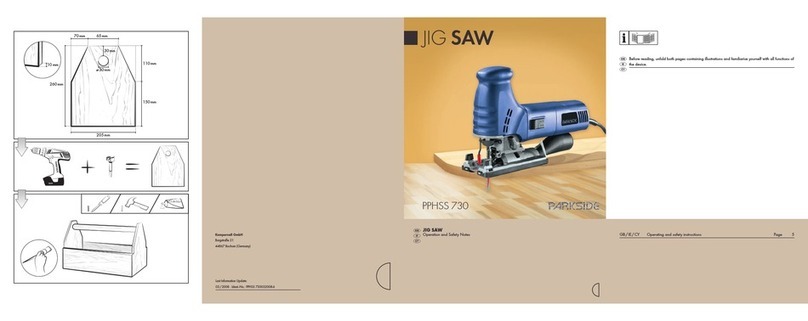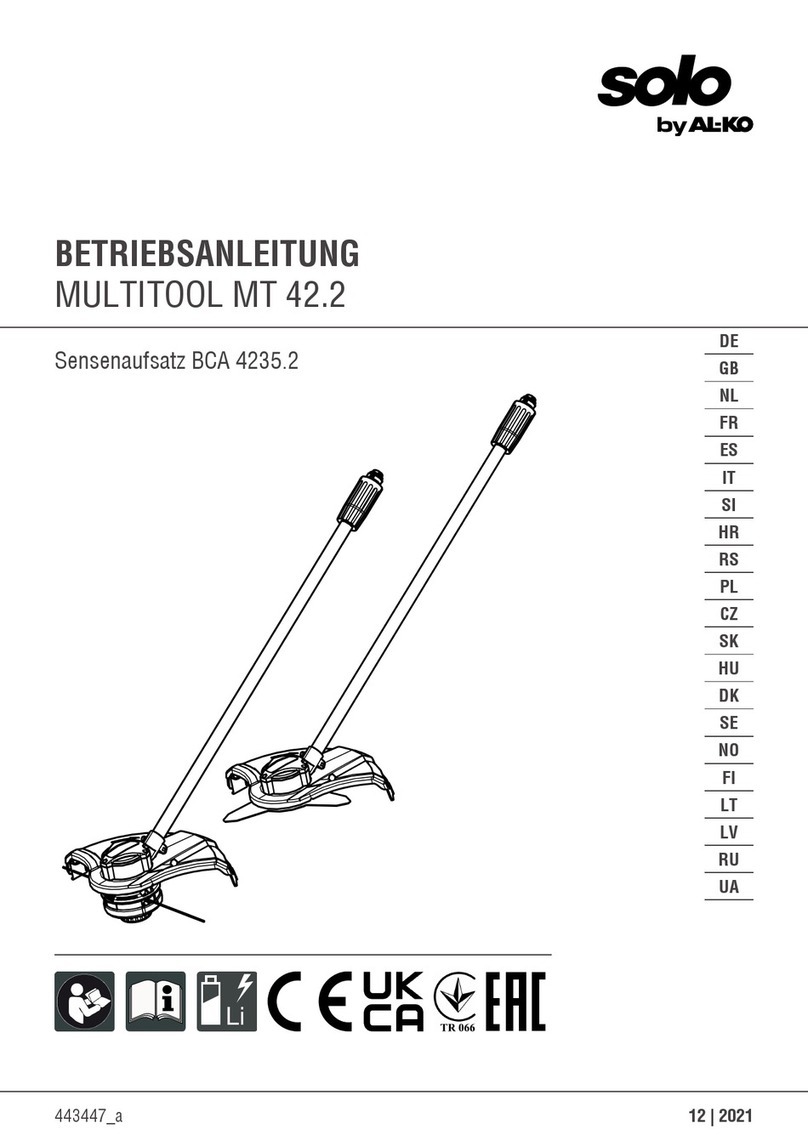Power Master PXD Series User manual

PXD SERIES LOW PROFILE
HYDRAULIC TORQUE WRENCHES
OPERATION
MANUAL
SOLUTIONS FOR EVERY BOLTING APPLICATION
INTRODUCING THE NEW GENERATION POWER TOOL

Thank you for buying the New PXD Tool.
This manual is designed to provide you with the basic knowledge required to operate and maintain your bolting
equipment. Please read this manual carefully and follow the instructions provided.
SAFETY PRECAUTIONS
Hydraulic Torque Wrench is a power tool enables the user to more easily accomplish bolting tasks with increased force, accuracy and efficiency.
It is due to the powered nature of the tools, with large forces generated from high pressure fluid/air applied to a variety of applications, that
adherence to strict safety issues through the proper design and documented use for tools. However, the user must accept the primary
responsibility of safety when using tools by reading, understanding and complying with all operating instructions prior to and during operation.
This manual and additional safety related services are designed to assist in the proper training for use and care of tools and play a major role in
preventing accidents or personal injury and increasing safety.
The following safety related operating instructions and tips are documented in the manual will assist you:
WHILE PLACING TOOL IN SERVICE
· Follow International Standards Safety Code of Hydraulic Rams and Jacks for operate, inspect and maintain this Hydraulic torque
wrench.
· This Hydraulic torque wrench is operated by connecting to hydraulic power pack. The Hydraulic power pack can be driven by
pneumatically or electrically. Before using the Hydraulic torque wrench read and follows the safety instructions given in pump manual.
· Use Hydraulic power pack which is generating 10,000 psi (681 bars) maximum pressure for the operation of this Hydraulic torque
wrench.
· Use Twin Line Hydraulic hose rated for 10,000 psi (681 bars) pressure having safety ratings of 4:1 with this tool.
· Use High Pressure Quick releasing couplers for quick connection of Hydraulic torque wrench to the hose and pump. Make sure that
the spring-loaded retaining rings are fully engaged and the safety rings are tightly threaded against the spring-loaded retaining
rings to prevent the connectors from disengaging under pressure.
· Never interchange male female High Pressure Quick Releasing Couplers fitted on Hydraulic torque Wrench or on the hose. Reversing
the high pressure coupler fittings will reverse the power stroke cycle and may damage the Hydraulic torque wrench.
· Check for damaged, worn or deteriorated hoses and fittings. Make sure that the hoses are being used are pressure tested and Approved
by International Standard.
· Before starts operating check the oil level in the reservoir of Hydraulic power pack, refill, replenish the oil if required.
Safety Precautions
2
PXD Series Operation Manual

10,000 psi
(700 bar) Do not handle pressurised hoses and be sure they are clear of any possible reaction surface during operation.
Test couplers when coupled with hydraulic equipment for pressure test.
Always wear eye protection when operating or performing maintenance on this tool.
Always wear head and hand protection and protective clothing when operating this tool.
Do not carry the Hydraulic Torque Wrench with the help of hoses.
Do not attempt to support the Hydraulic Torque Wrench with the hands during operation.
Keep hands, loose clothing and long hair away from the reaction arm and working area during operation.
This Hydraulic Torque wrench will exert a strong reaction force. The reaction arm to be supported firmly to
control the reaction force. Do not position the reaction arm so that it tilts the Hydraulic Torque wrench off the
axis of the bolt.
Do not use the swivel inlets as a reaction stop.
This tool is not insulated against electric shock. When using this tool with a pump having an electrical power
make sure that the earthling is proper.
This tool is not designed for working in explosive atmospheres
Avoid sharp bends and kinks that will cause severe back-up pressure in hoses which will lead to premature
failure of the hose.
Use only impact sockets and accessories. Do not use hand (chrome) sockets or accessories.
Use only sockets and accessories that correctly fit the bolt or nut and function without tilting the tool off the
axis of the bolt.
We will not be held liable for any personal injury, property damage caused, interruption
of business, loss of profits, losses of any kind, etc., resulting from any failure that occurs from the
use of our product. Additionally, we will not be liable to repair or replace any product, which
has been damaged, used improperly or has been subject to an unauthorized repair by the purchaser
or a third party.)
Safety is one of our primary concerns. By following these few simple precautions you'll be sure
to obtain the most beneficial use of wrench system in the safest manner possible.
WHILE USING THE TOOL
Warning
Use accessories recommended by us.
3
PXD Series Operation Manual

Table Of Contents
1 INTRODUCTION
1.1 TECHNICAL SPECIFICATION
1.2 DIMENSIONS
1.3 SECTIONAL VIEW PXD SERIES SQUARE DRIVE HYDRAULIC TORQUE WRENCHES
2 OPERATION
2.1 OPERATING INSTRUCTIONS
2.2 ADJUSTMENTS
2.3 OPERATING THE WRENCH
2.4 LUBRICATION
3 MAINTENANCE
3.1 DISASSEMBLY
3.2 ASSEMBLY
3.3 FAULT FINDING AND TROUBLE SHOOTING
3.4 ACCESSORIES OF PXD SERIES SQUARE DRIVE HYDRAULIC TORQUE WRENCHES
This tool when used in conjunction with the specified console and hoses conforms
to the requirements for CE Marking. Contact us for a list of approved components.
4
PXD Series Operation Manual

Model No. PXD-1 PXD-2 PXD-4 PXD-8 PXD-16 PXD-32 PXD-45
Tool Hex mm / inch from 13 / 1/2 19 / ¾ 25 /1 50 / 1.7/8 65 / 2.5/8 80 / 3.1/8 80 /
3.1/8
to 41/1.5/8 60 / 2.3/8 80 / 3.1/8 105 / 4 115 / 4.5/8 165 / 6.1/2 165 / 6.1/2
Min Torque Kg-m (ft/lbs) 6(45) 26 (192) 54 (395) 115 (830) 245 (1560) 445 (3220) 658 (4865)
Max Torque Kg-m (ft/lbs) 77(560) 260 (1928) 540 (3950) 1192 (8630) 2293 (16600) 4924 (35650) 6410(47380)
Output Accuracy +/-3% +/-3% +/-3% +/-3% +/-3% +/-3% +/-3%
Repeatability 100% 100% 100% 100% 100% 100% 100%
Duty Cycle 100% 100% 100% 100% 100% 100% 100%
Corrosion Protection Standard
Cylinder Weight Kg / Lbs 0.50/(1) 1.59 / (3.50) 2.73 / (6.00) 5.32 / (11.70) 7.27 / (16.00) 11.82 / (26.00) 13.70 / (30.20)
Link Weight Kg / Lbs From 0.50/(1) 1.09 / (2.40) 2.45 / (5.40) 5.41 / (11.90) 9.55 / (21.00) 1 3 . 1 8 /
PXD Series Low Profile Hydraulic Torque Wrenches Round Cylinder are designed for installing and removing large bolts having minimal
wrench clearance. These Hydraulic Torque Wrenches used at windmill, offshore platforms, power plants, steel erection sites and other
locations requiring accurate high torque during bolt tightening and also where maximum torque during failure of the bolt.
1.3 SECTIONAL VIEW PXD SERIES LOW PROFILE HYDRAULIC TORQUE WRENCHES:
Figure 1 - Dimensions of PXD Series Low Profile Hydraulic Torque Wrench
1.2.1 Refer Figure 1
1.1 TECHNICAL SPECIFICATION:
1.2 DIMENSIONS:
1.3.1 Refer Figure 2
Figure 2 - Sectional View of PXD series Low Profile Hydraulic Torque Wrenches
PXD SERIES LOW PROFILE HYDRAULIC TORQUE WRENCHES ROUND CYLINDER
1. Introduction
Model No.
mm inch mm inch mm inch mm inch mm inch mm inch mm inch
Length 111.00 4.37 167.00 6.57 203.20 8.00 253.00 9.96 330.00 13.00 390.00 15.35 450.00 17.71
Height 82.60 3.25 103.00 4.05 144.00 5.66 179.50 7.06 193.80 7.63 278.00 10.94 278.00 10.94
Width 19.80 0.78 38.00 1.49 50.70 1.99 59.50 2.34 65.00 2.56 84.00 3.30 84.00 3.30
Radius 5.80 0.23 9.30 0.36 11.85 0.46 13.90 0.54 16.80 0.66 23.75 0.94 23.75 0.94
PXD-1 PXD-2 PXD-4 PXD-8 PXD-16 PXD-32 PXD-45
1 Round Shaped Cylinder
2 Engagement Rod
3 Never Lock Drive Segment
4 Multi Tooth Ratchet
5 Single Piece Drive Plate
6 Link Pin
7 In Line Reaction Pad
8 Steel Alignment Pin
9 End Cap ‘O’ Ring
10 360 X 360 swivel
11 PU Piston ‘O’ Ring
12 Slider
13 U-Cap Seal
Sr. No. Part Description
5
PXD Series Operation Manual

2. Operation
2.1 OPERATING INSTRUCTIONS :
2.1.1 PREPARATION FOR ARRANGING THE TOOL
1. Place the correct size link on the nut making sure that ratchet socket has fully engaged the nut.
2. Make sure the reaction point is firmly touched along a border or with a projecting part against a stationary object such as an
adjacent nut, flange, equipment housing, etc.
2.1.2 CONNECTING THE TOOL WITH POWERPACK
1. Attach the Drive Cylinder to twin line hoses with the help of quick releasing couplers.
2. Make sure that they are fully engaged and place the safety rings tightly against the spring–loaded retainer rings.
3. Connect the opposite ends of the hose to the power pack in the same manner.
4. Avoid hoses interception between Torque wrench body or reaction members.
5. Remove Link pin out of the Drive Cylinder.
6. Slide drive cylinder on selected Ratchet link by inserting the end of the cylinder between the side plates of the Ratchet Link.
7. Insert the Link Pin threw the side plates and Drive Cylinder to keep the complete unit intact.
8. Apply momentary pressure to the system to ensure proper tool placement.
PXD SERIES LOW PROFILE HYDRAULIC TORQUE WRENCHES
Refer Figure 3
Figure 3 - Link Pin Insertion
6
PXD Series Operation Manual

2.2 SETTING ADJUSTMENTS :
2.2.1 SETTING THE TORQUE
For desired torque Refer Table 1 conversion chart supplied for your PXD Series tool model. Read across to the corresponding pressure.
This pressure is to be set on the pump.
1. Hydraulic Power Pack is connected to the power supply and turns the pump on.
2. By Pressing the remote control button and holding it for some times all the pressure to build up on the gauge of the Hydraulic
Power Pack.
3. Adjust the pressure by loosening the lock nut that locks the pressure adjustment thumbscrew. Rotate the Thumbscrew clockwise
to increase the pressure and anticlockwise to decrease the pressure.
4. When decreasing pressure, it is necessary to turn the thumb-screw to a pressure setting BELOW what is desired and gradually
increase the pressure to the desired level.
5. When the required pressure is achieved then retighten the lock nut and cycle the tool again to confirm that the required pressure
setting has been obtained.
2. Operation
7
PXD Series Operation Manual

Table 1 - Torque Conversion Chart PXD Series
P.S.I. / FT. / lbs Bar / N.M.
PSI
PXD-1
ft./lbs
ft./lbs ft./lbs ft./lbs ft./lbs ft./lbs ft./lbs ft./lbs ft./lbs ft./lbs ft./lbs ft./lbs
17 to
27 mm
30 to
41 mm
19 to
46 mm
47 to
60 mm
All Hex
Sizes
All Hex
Sizes
All Hex
Sizes
All Hex
Sizes
65 to
100 mm
105 to
115 mm
80 to
115 mm
115 to
155 mm
80 to
115 mm
115 to
155 mm
115 to
155 mm
1/2”
to
1.1/8”
4.11/16
to
6.1/2
PXD-2
PXD-4 PXD-8
PXD-16 PXD-32 PXD-45
Hex
Sizes
1.3/16”
to
1.5/8”
3/4”
to
1.13/16”
1.7/8”
to
2.3/8”
2.5/8”
to
3.15/16”
2.7/16”
to
4.5/8”
4”
to
4.5/8”
4.11/16”
to
6.1/2”
2.7/16”
to
4.5/8”
Bar
PXD-1
N.m.
17 to
27 mm
30 to
41 mm
19 to
46 mm
47 to
60 mm
All Hex
Sizes
All Hex
Sizes
All Hex
Sizes
All Hex
Sizes
65 to
100 mm
105 to
115 mm
80 to
115 mm
115 to
155 mm
80 to
115 mm
115 to
155 mm
115 to
155 mm
1/2”
to
1.1/8”
4.11/16
to
6.1/2
PXD-2
PXD-4
PXD-8
PXD-16 PXD-32 PXD-45
Hex
Sizes
1.3/16”
to
1.5/8”
3/4”
to
1.13/16”
1.7/8”
to
2.3/8”
2.5/8”
to
3.15/16”
2.7/16”
to
4.5/8”
4”
to
4.5/8”
4.11/16”
to
6.1/2”
2.7/16”
to
4.5/8”
N.m. N.m. N.m. N.m. N.m. N.m. N.m. N.m. N.m. N.m. N.m.
8
PXD Series Operation Manual
68 67 90 260 285 535 1,125 2,115 2,250 4,324 5,016 6,351 6,577
82 79 104 312 342 644 1,357 2,535 2,700 5,260 6,019 7,341 7,834
95 90 118 365 399 752 1,590 2,955 3,150 6,195 7,022 8,330 9,091
109 102 132 416 455 854 1,822 3,382 3, 600 7,130 8,025 9,320 10,347
122 114 146 469 512 962 2,055 3,802 4,051 8,066 9,028 10,309 11,604
136 126 160 522 569 1,071 2,288 4,229 4,501 8,996 10,031 11,303 12,858
150 138 176 572 626 1,179 2,528 4,650 4,951 9,871 11,035 12,444 14,152
163 149 190 625 683 1,288 2,768 5,070 5,401 10,747 12,038 13,586 15,447
177 160 206 678 740 1,389 3,008 5,490 5,851 11,623 13,041 14,727 16,742
190 171 220 728 797 1,498 3,248 5,917 6,301 12,499 14,044 15,869 18,036
204 183 235 784 868 1,606 3,489 6,337 6,751 13,374 15,047 17,010 19,331
218 196 252 832 923 1,715 3,762 6,764 4,826 14,250 16,050 18,195 20,608
231 208 268 885 981 1,823 4,034 7,185 7,651 15,126 17,053 19,380 21,885
245 221 285 937 1,038 1,925 4,307 7,605 8,101 16,002 18,057 20,564 23,162
258 233 300 990 1,097 2,033 4,579 8,032 8,551 16,877 19,060 21,749 24,439
272 246 317 1,045 1,159 2,142 4,853 8,452 9,015 17,895 20,063 22,938 25,716
286 259 333 1,093 1,212 2,250 5,063 8,879 9,466 18,790 21,066 24,078 26,995
299 271 349 1,145 1,270 2,359 5,275 9,299 9,916 19,685 22,069 25,218 28,275
313 284 366 1,197 1,328 2,460 5,485 9,720 10,368 20,579 23,072 26,358 29,555
326 296 381 1,250 1,385 2,569 5,696 10,147 10,818 21,474 24,075 27,498 30,834
340 308 396 1,307 1,450 2,677 5,908 10,567 11,333 22,367 25,079 28,644 32,114
354 320 412 1,353 1,507 2,786 6,152 10,987 11,786 23,266 26,082 29,739 33,398
367 331 426 1,406 1,566 2,894 6,396 11,414 12,240 24,165 27,085 30,943 34,682
381 344 442 1,457 1,624 2,996 6,640 11,834 12,692 25,064 28,088 32,092 35,965
394 355 456 1,510 1,682 3,104 6,884 12,261 13,147 25,962 29,091 33,242 37,249
408 368 472 1,567 1,742 3,213 7,128 12,682 13,692 26,861 30,094 34,394 38,533
422 380 488 1,613 1,799 3,321 7,334 13,102 14,148 27,719 31,097 35,506 39,825
435 392 503 1,666 1,857 3,430 7,540 13,522 14,604 28,577 32,101 36,617 41,117
449 404 520 1,718 1,914 3,531 7,747 13,949 15,061 29,435 33,104 37,729 42,409
462 416 535 1,769 1,972 3,640 7,953 14,369 15,518 30,460 34,107 38,841 43,700
476 428 551 1,829 2,033 3,748 8,161 14,796 15,888 31,153 35,110 39,956 44,992
490 441 567 1,873 2,089 3,857 8,386 15,217 16,342 32,044 36,113 41,113 46,284
503 452 582 1,926 2,146 3,965 8,611 15,637 16,796 32,934 37,116 42,269 47,576
517 465 598 1,979 2,204 4,067 8,837 16,064 17,250 33,825 38,119 43,425 48,868
530 477 613 2,029 2,262 4,175 9,062 16,484 17,630 34,716 39,123 44,582 50,160
544 489 628 2,090 2,325 4,284 9,289 16,911 18,314 35,605 40,126 45,738 51,452
558 502 644 2,134 2,379 4,392 9,520 17,331 18,772 36,495 41,129 46,852 52,702
571 513 659 2,187 2,437 4,501 9,754 17,752 19,231 37,386 42,132 47,964 53,952
585 525 674 2,238 2,494 4,602 9,985 18,172 19,687 38,277 43,135 49,075 55,201
598 536 689 2,291 2,553 4,711 10,219 18,599 20,146 39,167 44,138 50,187 56,451
612 548 705 2,352 2,615 4,819 10,452 19,019 20,361 40,058 45,141 51,296 57,701
626 561 720 2,394 2,669 4,928 10,701 19,446 20,814 40,947 46,145 52,470 59,007
639 572 735 2,447 2,726 5,029 10,951 19,866 21,267 41,837 47,148 53,644 60,312
653 585 751 2,498 2,784 5,138 11,200 20,287 21,718 42,726 48,151 54,818 61,617
666 596 765 2,551 2,843 5,246 11,449 20,714 22,171 43,615 49,154 55,992 62,923
680 608 781 2,614 2,908 5,355 11,699 21,141 22,503 44,504 50,157 57,166 64,228
1,000 49 66 192 210 395 830 1,560 1,660 3,190 3,700 4,685 4,852
1,200 58 77 230 252 475 1,001 1,870 1,992 3,880 4,440 5,415 5,779
1,400 66 87 269 294 555 1,173 2,180 2,324 4,570 5,180 6,145 6,706
1,600 75 97 307 336 630 1,344 2,495 2,656 5,260 5,920 6,875 7,633
1,800 84 108 346 378 710 1,516 2,805 2,988 5,950 6,660 7,605 8,560
2,000 93 118 385 420 790 1,688 3,120 3,320 6,636 7,400 8,338 9,485
2,200 102 130 422 462 870 1,865 3,430 3,652 7,282 8,140 9,180 10,440
2,400 110 140 461 504 950 2,042 3,740 3,984 7,928 8,880 10,022 11,395
2,600 118 152 500 546 1,025 2,219 4,050 4,316 8,574 9,620 10,864 12,350
2,800 126 162 537 588 1,105 2,396 4,365 4,648 9,220 10,360 11,706 13,305
3,000 135 173 578 640 1,185 2,574 4,675 4,980 9,866 11,100 12,548 14,260
3,200 145 186 614 681 1,265 2,775 4,990 3,560 10,512 11,840 13,422 15,202
3,400 153 198 653 724 1,345 2,976 5,300 5,644 11,158 12,580 14,296 16,144
3,600 163 210 691 766 1,420 3,177 5,610 5,976 11,804 13,320 15,170 17,086
3,800 172 221 730 809 1,500 3,378 5,925 6,308 12,450 14,060 16,044 18,028
4,000 181 234 771 855 1,580 3,580 6,235 6,650 13,201 14,800 16,921 18,970
4,200 191 246 806 894 1,660 3,735 6,550 6,983 13,861 15,540 17,762 19,914
4,400 200 257 845 937 1,740 3,891 6,860 7,315 14,521 16,280 18,603 20,858
4,600 209 270 883 980 1,815 4,046 7,170 7,648 15,181 17,020 19,444 21,802
4,800 218 281 922 1,022 1,895 4,202 7,485 7,980 15,841 17,760 20,285 22,746
5,000 227 292 964 1,070 1,975 4,358 7,795 8,360 16,500 18,500 21,130 23,690
5,200 236 304 998 1,112 2,055 4,538 8,105 8,694 17,163 19,240 21,978 24,637
5,400 244 314 1,037 1,155 2,135 4,718 8,420 9,029 17,826 19,980 22,826 25,584
5,600 254 326 1,075 1,198 2,210 4,898 8,730 9,363 18,489 20,720 23,674 26,531
5,800 262 336 1,114 1,241 2,290 5,078 9,045 9,698 19,152 21,460 24,522 27,478
6,000 271 348 1,156 1,285 2,370 5,258 9,355 10,100 19,815 22,200 25,372 28,425
6,200 280 360 1,190 1,327 2,450 5,410 9,665 10,437 20,448 22,940 26,192 29,378
6,400 289 371 1,229 1,370 2,530 5,562 9,975 10,773 21,081 23,680 27,012 30,331
6,600 298 384 1,267 1,412 2,605 5,715 10,290 11,110 21,714 24,420 27,832 31,284
6,800 307 395 1,305 1,455 2,685 5,867 10,600 11,447 22,470 25,160 28,652 32,237
7,000 316 406 1,349 1,500 2,765 6,020 10,915 11,720 22,981 25,900 29,475 33,190
7,200 325 418 1,382 1,541 2,845 6,186 11,225 12,055 23,638 26,640 30,328 34,143
7,400 333 429 1,421 1,583 2,925 6,352 11,535 12,390 24,295 27,380 31,181 35,096
7,600 343 441 1,460 1,626 3,000 6,519 11,850 12,725 24,952 28,120 32,034 36,049
7,800 352 452 1,497 1,669 3,080 6,685 12,160 13,005 25,609 28,860 32,887 37,002
8,000 361 463 1,542 1,715 3,160 6,852 12,475 13,510 26,265 29,600 33,740 37,955
8,200 370 475 1,574 1,755 3,240 7,023 12,785 13,848 26,922 30,340 34,562 38,877
8,400 378 486 1,613 1,798 3,320 7,195 13,095 14,186 27,579 31,080 35,382 39,799
8,600 387 497 1,651 1,840 3,395 7,366 13,405 14,523 28,236 31,820 36,202 40,721
8,800 395 508 1,690 1,883 3,475 7,538 13,720 14,861 28,893 32,560 37,022 41,643
9,000 404 520 1,735 1,929 3,555 7,710 14,030 15,020 29,550 33,300 37,840 42,565
9,200 414 531 1,766 1,969 3,635 7,894 14,345 15,354 30,206 34,040 38,706 43,528
9,400 422 542 1,805 2,011 3,710 8,078 14,655 15,688 30,862 34,780 39,572 44,454
9,600 431 554 1,843 2,054 3,790 8,262 14,965 16,021 31,518 35,520 40,438 45,454
9,800 440 564 1,882 2,097 3,870 8,446 15,280 16,355 32,174 36,260 41,304 46,417
10,000 448 576 1,928 2,145 3,950 8,630 15,595 16,600 32,830 37,000 42,170 47,380

The position of the Low Profile Hydraulic Torque Wrench relative to the nut determines whether the action will be for Loosening or Tightening
of the nut. Refer figure 4 for Low Profile Hydraulic Torque Wrench Position for Tightening and Loosening application.
The power stroke of the Piston Assembly will always turn the Ratchet Hex toward the Shroud.
Refer Figure 4
1 Place the correct size of Ratchet Hex on the nut. Ratchet Hex will fully engages the nut.
2. Place the reaction surface against an adjacent nut, flange or solid system component. Keep clearance for the hoses, swivels,
inlets and End Plug. Avoid direct contact of the tool with hoses, swivels, inlets or end plug.
3. Switch on the Hydraulic Power Pack preset the pressure for the required torque, used the remote control button to advance
the Piston Assembly. At the beginning if the notch in the piston rod did not engage the Retract Pin in the Ratchet Link when the
Link was joined to the Housing, it will engage the Pin automatically during the first forward stroke.
4. When the Low Profile Hydraulic Torque Wrench is started, the reaction surface of the wrench will move against the contact point
and the nut will begin to rotate.
5. When the nut stop rotating and the Pump Gauge reaches the preset pressure, a sound “click” will be heard , the piston rod will
retract to the normal conditions after releasing the remote control button and the Hydraulic Torque Wrench will resets itself.
6. Continue to cycle the hydraulic torque wrench until it reaches to the position where the preset torque has been achieved preset
pressure of Hydraulic Power Pack.
7. Once the nut stops rotating, cycle the Hydraulic Torque Wrench one last time to achieve total torque.
2.3 OPERATING THE WRENCH :
Figure 4 - Reaction Point
LOOSEN
TIGHTEN
SHROUD
REACTION POINT
9
PXD Series Operation Manual

2.4 LUBRICATION :
The frequency for the lubrication is dependent on operating conditions The Hydraulic Torque Wrench used in a clean enclosed
environment will require less servicing than a tool used open atmosphere and dropped in loose dirt or sand. Synthetic Grease is used
for lubrication. Whenever lubrication is required, lubricate as follows:
1. By removing Link Pin separate the Low Profile Cylinder from the Ratchet Link if they are joined.
2. After wiping of the old grease, apply Synthetic Grease to the hook notch in the Piston rod and make a thin layer of Synthetic Grease
onto the sides and faces of the two Sliders.
3. Disassemble the Ratchet Link as instructed in the Section 3 of the Maintenance and wash the components in a suitable cleaning
solution in a well-ventilated area.
4. Dry the components, then apply a film of Synthetic Grease onto the wear surface of both Side Plate Sleeves and the hubs of the
Ratchet.
5. Apply a light film of Synthetic Grease onto the inner faces of both Side Plates covering the area where the Drive Plate and
Drive Segment Pawl travel. DO NOT over grease the teeth of the Drive Segment or Ratchet. It can prevent the teeth from
engaging properly.
6. Reassemble the Ratchet Link as instructed in the Maintenance Section.
Refer Figure 5
10
PXD Series Operation Manual
Figure 5 - Wrench Lubrication Point
4321
5
7
6

3. Maintenance
Refer figure 6 for PXD-2, 4, 8, 16, 32 and 45 Series Swivel.
Refer figure 7 for PXD-1 Series Ratchet Link.
Refer figure 8 for PXD-2, 4 and 8 Series Ratchet Link.
Refer figure 9 for PXD-16 and 32 Series Ratchet Link.
Refer table 2 for Part Identification of PXD-1,2, 4, 8, 16 and 32 Series Ratchet Link.
Refer figure 10 for PXD-1 Series Cylinder.
Refer table 3 for Part Identification of PXD- 1 Series Cylinder.
Refer figure 11 for PXD-2, 4 and 8 Series Cylinder.
Refer figure 12 for PXD-16 and 32 Cylinder.
Refer table 4 for Part Identification of PXD- 2, 4, 8, 16 and 32 Series Cylinder.
Refer figure 13 for PXD-45 Cylinder.
Refer table 5 for Part Identification of PXD- 45 Series Cylinder.
Figure 6 - PXD - 2, 4, 8, 16, 32 Series Swivel
PXD SERIES LOW PROFILE HYDRAULIC TORQUE WRENCHES
11
PXD Series Operation Manual

Figure 7 - PXD-1 Series Ratchet Link
Figure 8 - PXD – 2, 4 and 8 Series Ratchet Link
12
PXD Series Operation Manual

Figure 9 - PXD – 16 and 32 Series Ratchet Link
Table 2 – Part Identification of PXD-1, 2, 4, 8, 16 and 32 Series Ratchet Link
SR. Qty. PXD-2 PXD-4 PXD-8 PXD-16 PXD-32
DESCRIPTION PXD-1
No. PART NO PART NO PART NO PART NO PART NO PART NO
1 Side Plate-L 1 BT-001020-01 BT-001021-01 BT-001022-01 BT-001023-01 BT-001024-01 BT-001025-01
2 Sleeves-Side plate 2 BT-001020-12 BT-001021-12 BT-001022-12 BT-001023-12 BT-001024-12 BT-001025-12
3 Lower Spacer 1 N/A BT-001021-10 BT-001022-10 BT-001023-10 BT-001024-10 BT-001025-10
4 Lower spacer pin 2 BT-001020-11 BT-001021-11 BT-001022-11 BT-001023-11 BT-001024-11 BT-001025-11
5 Ratchet 1 BT-001020-06 BT-001021-06 BT-001022-06 BT-001023-06 BT-001024-06 BT-001025-06
6 Drive Plate 1 BT-001020-03 BT-001021-03 BT-001022-03 BT-001023-03 BT-001024-03 BT-001025-03
7 Drive segment 1 BT-001020-07 BT-001021-07 BT-001022-07 BT-001023-07 BT-001024-07 BT-001025-07
8 Segment Spring 1 BT-001020-14 BT-001021-14 BT-001022-14 BT-001023-14 BT-001024-14 BT-001025-14
9 Spring pin rolled 1 2050043 2050057 2050076 2050098 2050181 2050181
10 Drive pin 1 BT-001020-04 BT-001021-04 BT-001022-04 BT-001023-04 BT-001024-04 BT-001025-04
11 Upper spacer 1 N/A BT-001021-08 BT-001022-08 BT-001023-08 BT-001024-08 BT-001025-08
12 Hex countersunk flat screw 4 N/A 1550001 1550001 155001 1550001 1550001
13 Socket head cap screw 4 100001 100001 100001 1110001 100001 110001
14 Side Plate-R 1 BT-001020-02 BT-001021-02 BT-001022-02 BT-001023-02 BT-001024-02 BT-001025-02
15 Button head cap screw 2 NA 110001 110001 100001 110001 100001
16 Drive pin spring 1 BT-001020-05 BT-001021-05 BT-001022-05 BT-001023-05 BT-001024-05 BT-001022-05
17 Shroud 1 N/A BT-001021-13 BT-001022-13 BT-001023-13 BT-001024-13 BT-001022-13
18 Middle spacer 1 N/A N/A N/A N/A BT-001024-49 BT-001025-49
19 Spring pin 1 N/A N/A N/A N/A 2050059 2050059
13
PXD Series Operation Manual

Table 3 – Part Identification of PXD-1 Series Cylinder
SR. NO. PART PXD-1
1 HOUSING PXD1-20-15
2 PISTON BRASS BUSHING PXD1-20-16
3 PISTON ROD ASSEMBLY PXD1-20-0B
PISTON ROD PXD1-20-18
4 PISTON CAP PXD1-20-19
5 VALVE BALL N/A
6 VALVE SPRING N/A
7 WASHER N/A
8 VALVE HOLLOW LOCK N/A
9 SLIDER PXD1-20-23
10 END CAP PXD1-20-24
11 RETAINING RING N/A
12 LINK PIN PXD1-20-25
13 END COVER N/A
14 END COVER SCREWS N/A
15 BALL PLUNGER 2200013
16 SLIDER PIN 02050014
17 END PLUG SEAL 9040031
18 ROD SEAL 9390010
19 PISTON O-RING 9040032
20 SWIVEL (2 req) N/A
SWIVEL (2 req) N/A
21 COUPLER ASSEMBLY HC-S100
22 SEAL INSERTION TOOL N/A
23 END PLUG WRENCH N/A
24 PISTON CAP ROD SEAL N/A
Figure 10 - PXD – 1 Series Cylinder
14
PXD Series Operation Manual

Table 4 – Part Identification of PXD-2, 4, 8, 16 and 32 Series Round Cylinder
S R. NO. PART PXD-2 PXD-4 PXD-8 PXD-16 PXD-32
1 HOUSING PXD2-21-15 PXD4-22-15 PXD8-23-15 PXD16-24-15 PXD32-25-15
2 PISTON BRASS BUSHING N/A PXD4-22-16 PXD8-23-16 PXD16-24-16 PXD32-25-16
3 PISTON ROD ASSEMBLY PXD2-21-0B PXD4-22-0B PXD8-23-0B PXD16-24-16 PXD32-25-0B
PISTON ROD PXD2-21-18 PXD4-22-18 PXD8-23-18 PXD16-24-18 PXD32-25-18
4 PISTON CAP N/A N/A N/A PXD16-24-19 PXD32-25-19
5 VALVE BALL N/A N/A N/A 2140006 2140006
6 VALVE SPRING N/A N/A N/A PXD16-24-21 PXD32-25-21
7 WASHER N/A N/A N/A N/A 01310007
8 VALVE HOLLOW LOCK N/A N/A N/A PXD16-24-22 PXD32-25-22
9 SLIDER PXD2-21-23 PXD4-22-23 PXD8-23-23 PXD16-24-23 PXD32-25-23
10 END CAP PXD2-21-24 PXD4-22-24 PXD8-23-24 PXD16-24-24 PXD32-25-24
11 RETAINING RING N/A N/A N/A N/A N/A
12 LINK PIN PXD2-21-25 PXD4-22-25 PXD8-23-25 PXD16-24-25 PXD32-25-25
13 END COVER N/A N/A N/A N/A N/A
14 END COVER SCREWS N/A N/A N/A N/A N/A
15 BALL PLUNGER 2200007 2200008 2200009 2200010 2200011
16 SLIDER PIN 2050076 2050095 2050126 2050151 2020145
17 END PLUG SEAL 9040021 9040020 9040023 9040025 9040027
18 ROD SEAL 9390003 9390004 9390005 9390006 9390007
19 PISTON O-RING 9040019 9040022 9040024 9040026 9040028
20 SWIVEL (2 req) N/A PXD-4M-4M PXD-4M-4M PXD-4M-4M PXD-4M-4M
SWIVEL (2 req) PXD-4M-8M N/A N/A N/A N/A
21 COUPLER ASSEMBLY HC-S100 HC-S100 HC-S100 HC-S100 HC-S100
22 SEAL INSERTION TOOL N/A N/A N/A N/A N/A
23 END PLUG WRENCH PXD-2-EPW PXD-4-EPW PXD-8-EPW PXD-16-EPW PXD-32-EPW
Figure 12 - PXD – 16 and 32 Series Cylinder
916
9
15
12
218 4
5
678
23
21
20
10
17
19
21
20
1
3
Figure 11 - PXD – 2, 4, 8 Series Round Cylinder
15
PXD Series Operation Manual

Table 5 – Part Identification of PXD-45 Series Cylinder
S R. NO. PART PXD-45
1 HOUSING PXD45-26-15
2 PISTON BRASS BUSHING PXD45-26-16
3 PISTON ROD ASSEMBLY PXD45-26-0B
PISTON ROD PXD45-26-18
4 PISTON CAP PXD45-26-19
5 VALVE BALL 2140006
6 VALVE SPRING PXD45-26-21
7 WASHER 01310007
8 VALVE HOLLOW LOCK PXD45-26-22
9 SLIDER PXD45-26-23
10 END CAP PXD45-26-24
11 RETAINING RING N/A
12 LINK PIN PXD45-26-25
13 END COVER N/A
14 END COVER SCREWS N/A
15 BALL PLUNGER 2200012
16 SLIDER PIN 2020145
17 END PLUG SEAL 9040029
18 ROD SEAL 9390008
19 PISTON O-RING 9040030
20 SWIVEL (2 req) PXD-4M-4M
SWIVEL (2 req) N/A
21 COUPLER ASSEMBLY HC-S100
22 SEAL INSERTION TOOL N/A
23 END PLUG WRENCH PXD-45-EPW
24 PISTON CAP ROD SEAL 9390009
Figure 13 - PXD – 45 Series Cylinder
16
PXD Series Operation Manual

3.1.1 General Instructions
1. Do not disassemble the tool unless until required to replace or repair damaged parts.
2. Take precautionary measure while handling surfaces that will contain hydraulic oil under pressure.
1. Do not disassemble the tool unless until required to replace or repair damaged parts.
2. Take precautionary measure while handling surfaces that will contain hydraulic oil under pressure.
3. Hold a wrench in a leather–covered or copper–covered vise jaws to protect the surface of the part and help prevent distortion.
This is particularly for the threaded part and housings.
4. Do not remove any part that is a press fit in or on an assembly unless the removal of that part is necessary for repairs or replacement.
5. Do not disassemble the hydraulic cylinder assembly unless you are in a position of complete set of seals and O-rings for replacement.
6. Use only Standard size tools when disassembling these Hydraulic Torque Wrenches.
3.1.2 Steps for Disassembly of the Wrench
1. Remove the Link Pin out of the Housing and Side Plates (L and R).
2. Lift the Housing from between the Side Plates and separate the two units.
3.1.3 Step for Disassembly of the PXD-2, PXD-4 and PXD-8 Cylinder Assemblies
1. Hold the Housing in copper-covered or leather covered vise jaws with the inlet end upward and using a Allen Key, unscrew and
remove the two Swivel Inlets with their attached Couplers.
2. Remove the Housing Assembly from the vise jaws; collect the oil in container by moving the Piston Rod back and forth several
times to purge the hydraulic oil from the Housing.
3. Hold the Housing in copper-covered or leather covered vise jaws with the inlet end upward.
4. Press the piston end of the Piston Rod forward in the Housing until the Slider Pin aligns with the cross holes in the Housing.
5. Using a small drift, tap the Slider Pin out of the Sliders and position shaft and remove the two Sliders.
6. Remove end cap using End cap wrench along with End cap O-ring.
7. Push the piston out of the Housing.
8. Replace Rod Seal by using a hooked tool to pull it out of the Housing.
3.1.4 Step for Disassembly of the PXD-16, PXD-32 and PXD-45 Cylinder Assemblies
1. Hold the Housing in copper-covered or leather covered vise jaws with the inlet end upward and using a 1/4” hex wrench, unscrew
and remove the two Swivel Inlets with their attached Couplers.
2. Remove the housing assembly from the vise jaws and over a container to collect the oil, move the Piston Rod Assembly back and
forth several times to purge the hydraulic oil from the Housing.
3. Hold the Housing in copper-covered or leather covered vise jaws with the inlet end upward.
4. Insert the pins of the End Plug Wrench into the holes of the End Cap. Using a wrench on the hex of the End Plug Wrench, unscrew
and remove the End Cap with the End Plug Seal.
5. Push the Piston Rod far enough into the Housing to expose the hex on the piston head.
3.1 DISASSEMBLY OF WRENCH:
17
PXD Series Operation Manual

During removal and after the piston shaft is removed; DO NOT hold the round portion of the shaft with any
holding device that will damage the surface. To avoid hydraulic oil leak do not allow nicks or scratches to the
surface.
6. Using a socket on the hex of the piston head unscrew and remove the piston head from the shaft with the Piston O-ring.
7. Pull the Piston shaft out of the Housing.
8. Replacing Sliders position the Slider Pin over a clearance opening in a soft block and use a small drift to tap the Pin out of the
Sliders and shaft.
9. If the Rod Seal needs replacement, use a hooked tool to pull it out of the Housing.
3.1.5 Step for Disassembly of the Ratchet Link
1. Keep the Ratchet Link flat on a workbench with the Left Side Plate downward and using an Allen Key, unscrew and remove the
two Lower Spacer Screws.
2. Using an Allen key, unscrew and remove the two Upper Spacer Screws.
3. By using roll pin punch tap the Spacer Roll Pin out of the Right Side Plate For Series PXD-16, PXD-32.
4. Applying thumb pressure to the edge of the Ratchet, carefully lift the Side Plate off the Assembly.
5. Hold the Ratchet and Drive Plate and, while maintaining their relationship, lift them both off the Left Side Plate.
6. Push the Ratchet out of the Drive Plate and Remove the Drive Segment and the Segment Spring from the Drive Plate Recess.
7. By using roll pin punch replace the Drive Pin or Drive Pin Spring; use a roll pin punch to push the Drive Pin Spring Roll Pin out of the
Drive Plate. Once the Pin Spring is removed, the Drive Pin will drop down to the large opening at the bottom of the slot for easy removal.
8. Lift the Lower Spacer off the Lower Spacer Pins. If the Pins must be replaced, use a Allen key to remove the two Lower Spacer
Screws from the Right Side Plate. Pull the Pins out of the holes on the inner face of the Right Side Plate.
9. For Series PXD-2, PXD-4, and PXD-8, unscrews the two Spacer Screws and remove the Upper Spacer from the Right Side Plate. For
Series PXD-16 and PXD-32 uses a roll pin punch to remove the Spacer Roll Pin from the Right Side Plate. Unscrew the two Spacer
Screws and remove the Middle Spacer and Upper Spacer from the Right Side Plate.
10. Replace the Side Plate Sleeves by pressing the Sleeves out toward the inner face of the Side Plate.
3.2 ASSEMBLY OF WRENCH:
3.2.1 General Instructions
1. Take precautionary measure while handling surfaces that will contain hydraulic oil under pressure.
2. Hold a wrench in a leather–covered or copper–covered vise jaws to protect the surface of the part and help prevent distortion.
This is particularly for the threaded part and housings.
3. Apply 'O'–ring lubricant to all 'O'–rings before final assembly.
3.2.2 Step for Assembly of the Ratchet Link
1. Insert the Side Plate Sleeves by pressing, new sleeves shoulder end trailing into the Right and Left Side Plates from the inner face
of the side Plates. Assure that the Sleeves are square with the side plate faces and the shoulder of the Sleeves enters the
recesses in the Side Plates and are pressed flush with the faces.
2. For Series PXD-2, PXD-4, and PXD-8 position the Upper Spacer against the inside faces of the Right Side Plate by applying a non
permanent thread-locking compound to the threads of the two Upper Spacer Screws and tighten the Spacer with the Screws
through the Side Plate.
18
PXD Series Operation Manual

3. For Series PXD-16 and PXD-32 presses the Spacer Roll Pin into the Right Side Plate with one end of the Pin flush with the outer face
of the Side Plate. Insert the tab of the Upper Spacer into the slot in the Middle Spacer, and after aligning the holes in both pieces,
install them on the Spacer Roll Pin. When they are correctly positioned, apply a non-permanent thread-locking compound to the
threads of the two Upper Spacer Screws and tighten the Spacers with the Screws through the side plate.
4. Insert the two Lower Spacer Pins into the holes in the lower edge of the Right Side Plate. Apply a nonpermanent thread-locking
compound to the threads of the Lower Spacer Screws and tighten the Pins with the Screws through the Side Plate.
5. Place the Lower Spacer over the Pins against the Side Plate. Assure it is correctly oriented so that no part of the Spacer extends
beyond the edge of the Side Plate.
6. Insert the Drive Pin into the small cross-hole and slot in the Drive Plate. Turn the Plate which helps the ends of the Pin to enter
the slot and move the Pin to the narrow end.
7. Position the Drive Pin Spring in the drive plate slot with the two non-connected ends between the Drive Pin and the large hole in
the slot. Position the closed end of the spring on the opposite side of the Pin and then apply pressure on the spring to align the
hole through it with the hole in the Drive Plate for the Drive Pin Spring Roll Pin. Insert the Spring Roll Pin into the Drive Plate,
through the spring and into the far wall of the Drive Plate.
In the following step, when the Ratchet is removed from the Drive Plate, the Drive Segment and Segment Spring will be
free to fall from the Drive Plate recess. Prevent falling of the Drive Segment on a hard surface that might chip the teeth.
8. Apply a thin film of Synthetic Grease onto the inner race of the large opening in the Drive Plate.
9. Position the Ratchet in the central opening of the Drive Plate.
10. Insert the Drive Segment into the opening adjacent to the Ratchet.
Make certain the teeth of the Ratchet correctly engage the teeth of the Drive Segment. Reverse the Ratchet if they do
not properly engage.
11. Move the Drive Segment sideways to expose the spring hole. Insert the Segment Spring into the hole. While compressing the spring,
move the Drive Segment inward until the Drive Plate captures the Segment Spring.
12. Apply a light coat of Synthetic Grease to both sides of the Drive Plate and Drive Segment and to the inner races of both Side Plate
Sleeves.
13. While keeping the assembly together, insert the hub of the Ratchet into the Side Plate Sleeve of the assembled Side Plate.
14. Place the Left Side Plate Sleeve on the hub of the Ratchet and align the screw holes for the Spacers.
15. After applying a non-permanent thread-locking compound to the threads and using hex wrenches, install the two remaining
Lower Spacer Screws.
3.2.3 Step for Assembly of the PXD-16, PXD-32 and PXD-45 Cylinder
3.2.3.1 Assemblies
1. Hold the link retaining pin lug in copper-covered, vise jaws keeping the Housing horizontal.
2. Remove Rod Seal from the Housing, apply a coat of ‘O’-ring lubricant to the Seal and install it, lip end trailing, in the recess at the
bottom of the piston bore.
3. Push the Slider Pin into one of the Sliders flush with one side. Insert the Pin through the hole in the piston shaft and press the
remaining Slider onto the Pin.
4. Insert the Piston O-ring in the groove of the piston head.
5. Insert the piston rod, threaded end leading, into the small central opening from the non-piston end of the Housing. Notch direction
in the trailing end of the shaft should be toward the Ball Plunger.
19
PXD Series Operation Manual

6. Insert the piston, hex end trailing, into the bore of the Housing, and use socket to thread and tighten the piston onto the piston shaft.
7. Install the End Plug Seal in the groove on the hub of the End Cap.
8. Using the End Plug Wrench, thread the assembled End Cap, o-ring end leading, into the piston end of the Housing and tighten it.
9. Wrap the threads of the Swivel Sets with Teflon tape and thread the swivel with the male hose Coupler into the center of the End Cap.
Thread the Swivel with the female Coupler into the hole in the Housing directly above the End Cap.
3.2.4 Step for Assembly of the PXD-2, PXD-4 and PXD-8 Cylinder
3.2.4.1 Assemblies
1. Hold the link retaining pin lug in copper-covered vise jaws with the Housing horizontal.
2. Before inserting Rod Seal in the Housing, apply a coat of o-ring lubricant to the Seal and install it, lip end trailing, in the recess at
the bottom of the piston bore.
3. Insert the piston rod, notched end leading, into the Rod Seal and the small central opening from the piston end of the Housing.
The notch in the leading end of the shaft should be toward the Ball Plunger.
4. Push the Piston Rod inward until the hole for the Slider Pin aligns with the holes in the walls of the Housing.
5. Position one Slider on each side of the piston shaft and insert the Slider Pin through the hole in the Housing into both Sliders and
the piston shaft. The fit between the Pin and Sliders is an interference fit. Use a brass hammer and drift to set the Slider Pin
below the outer edge of both Sliders or deep enough to prevent the shaft ends from dragging on the Housing walls.
6. Install the End Plug Seal in the groove of the End Cap.
7. Insert the assembled End Cap into the Housing with the O-ring end leading and the threaded inlet hole upward. By using end cap
wrench tighten the end cap into the Cylinder.
In the following step, an excessive amount of grease will prevent proper tooth engagement between the Ratchet
and the Drive Segment causing the tool to malfunction.
In the following step, DO NOT use thread-locking compound on the screw threads.
8. Wrap the threads of the Swivel Sets with Teflon tape and thread the swivel with the male hose Coupler into the threaded hole
in the End Cap.
9. Apply some Synthetic Grease to the notch in the Piston Rod and the face of the Sliders.
3.2.5 Step for Assembly of the Tool
1. With the Cylinder Assembly in one hand and the Ratchet Link in the other, hook the notch on the shaft of the Piston Rod onto the
Drive Pin and bring the two assemblies together.
2. Insert the Link Pin into the hole in the Side Plate until the Ball Plunger snaps into the annular groove around the center of the
Link Pin.
20
PXD Series Operation Manual
This manual suits for next models
7
Table of contents
Popular Power Tools manuals by other brands
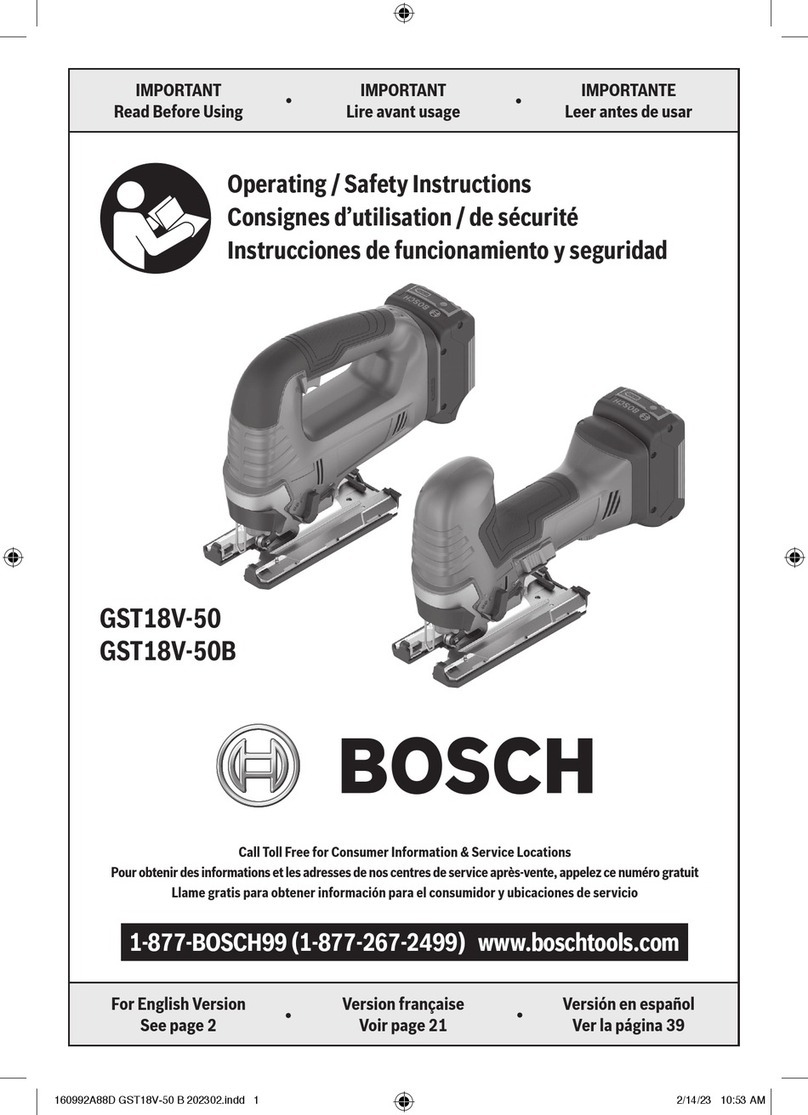
Bosch
Bosch GST18V-50B Operating/safety instructions
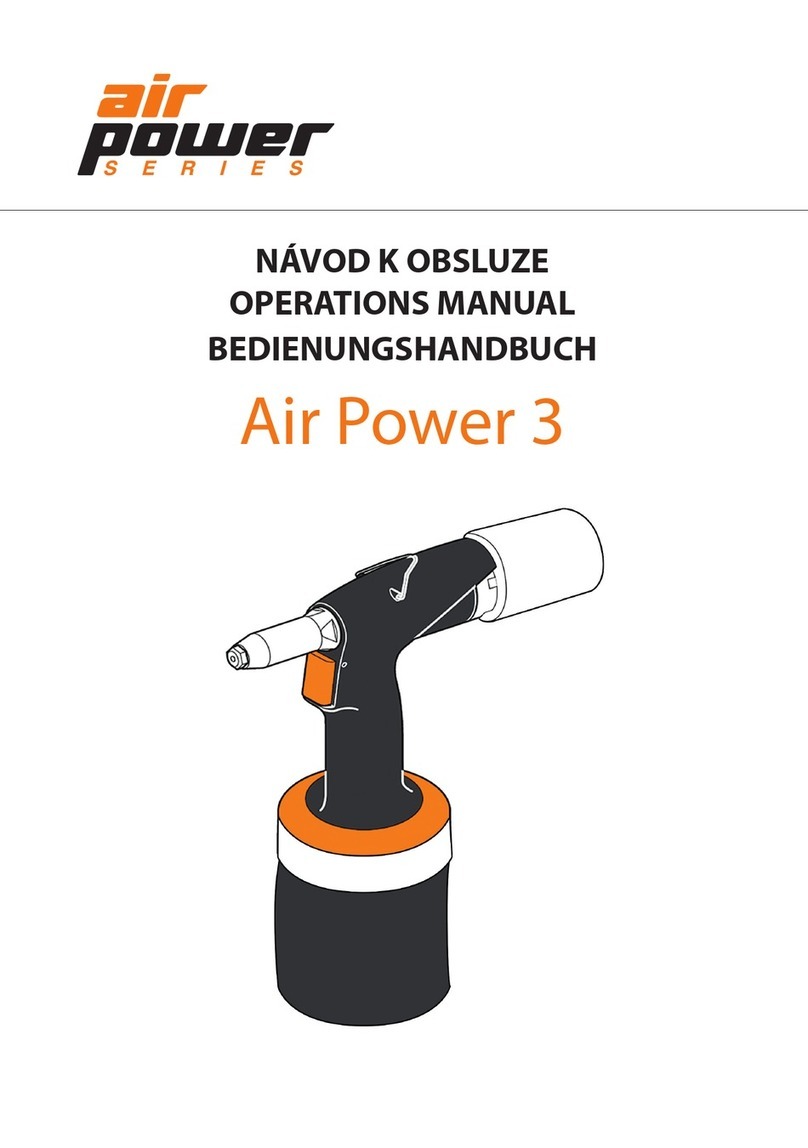
GOEBEL
GOEBEL Air power Series Operation manual
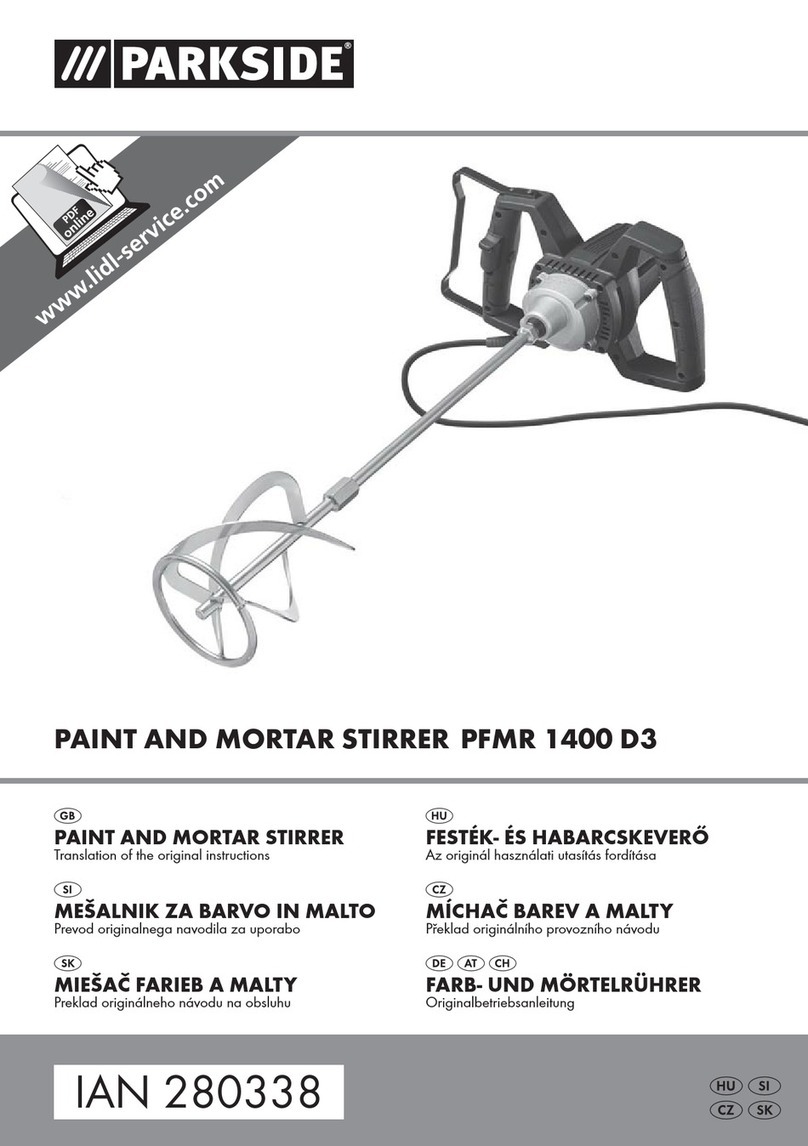
Parkside
Parkside PFMR 1400 D3 Translation of the original instructions
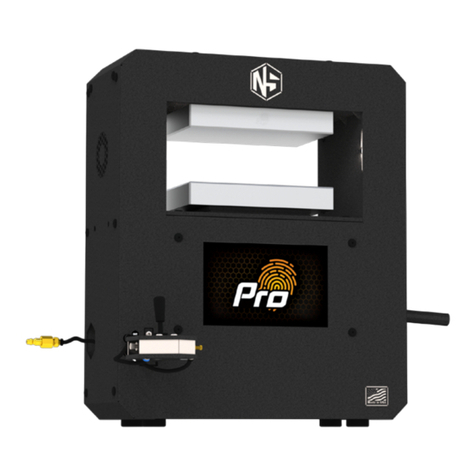
Nugsmasher
Nugsmasher ProTouch owner's manual
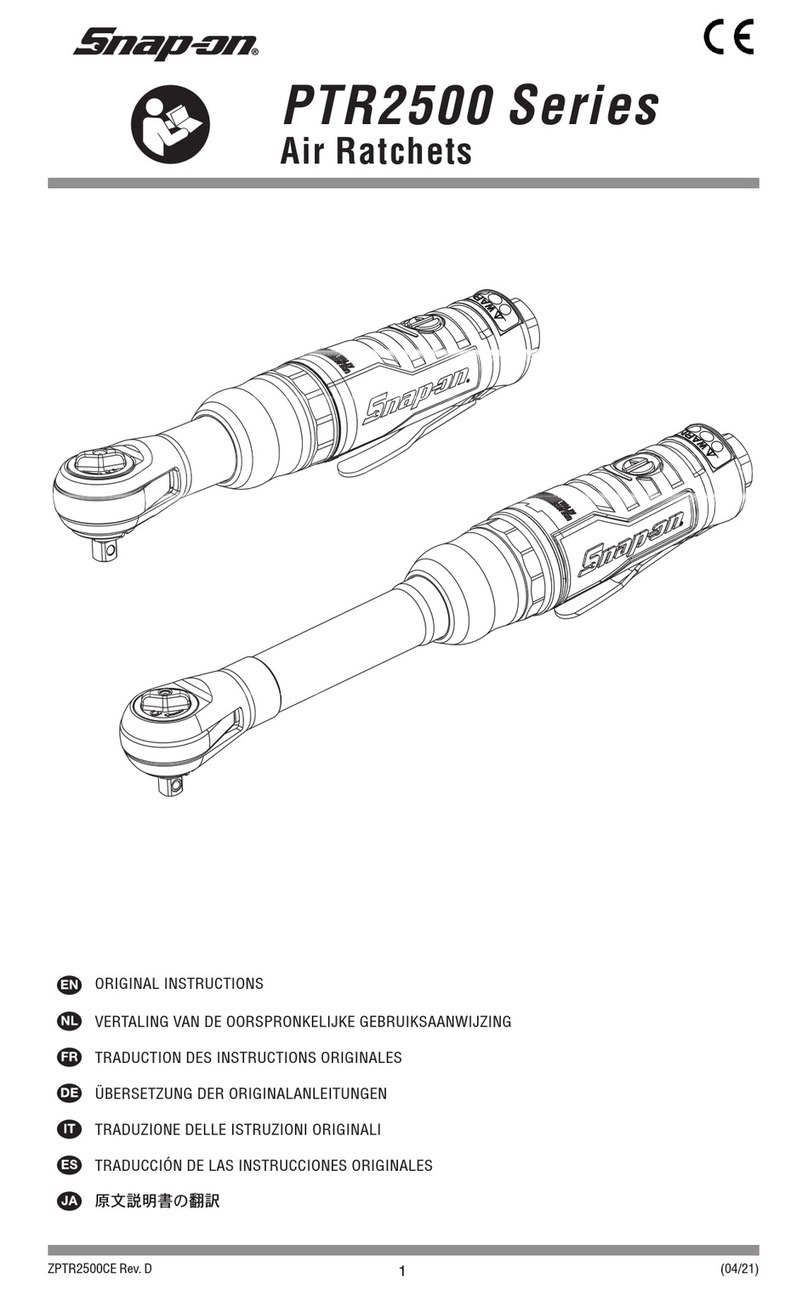
Snap-On
Snap-On PTR2500 Series Original instructions

Ferm
Ferm OTM1001 Original instructions

